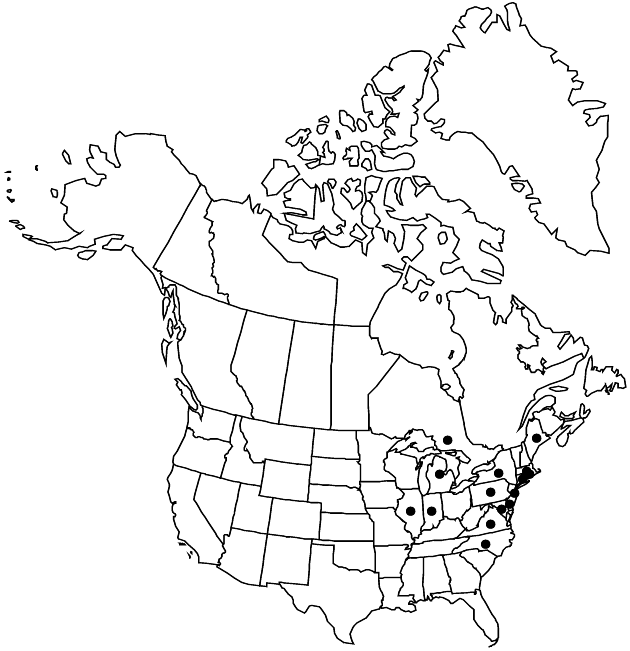Difference between revisions of "Pluchea odorata var. succulenta"
in A. E. Radford et al., Vasc. Fl. S.E. U.S. 1: 175. 1980.
FNA>Volume Importer |
FNA>Volume Importer |
||
| Line 11: | Line 11: | ||
|name=Pluchea purpurascens var. succulenta | |name=Pluchea purpurascens var. succulenta | ||
|authority=Fernald | |authority=Fernald | ||
| + | |rank=variety | ||
|publication_title=Rhodora | |publication_title=Rhodora | ||
|publication_place=44: 227. 1942 | |publication_place=44: 227. 1942 | ||
| Line 29: | Line 30: | ||
|elevation=0–10 m | |elevation=0–10 m | ||
|distribution=Ont.;Conn.;Del.;Ill.;Ind.;Maine;Md.;Mass.;Mich.;N.J.;N.Y.;N.C.;Pa.;R.I.;Va. | |distribution=Ont.;Conn.;Del.;Ill.;Ind.;Maine;Md.;Mass.;Mich.;N.J.;N.Y.;N.C.;Pa.;R.I.;Va. | ||
| − | |discussion=<p>The larger size of the heads of <i>Pluchea odorata </i>var.<i> succulenta</i> (versus < | + | |discussion=<p>The larger size of the heads of <i>Pluchea odorata </i>var.<i> succulenta</i> (versus <i></i>var.<i> odorata</i>) is correlated with the greater number of functionally staminate florets. The two taxa apparently intergrade across a wide area, from southeastern Virginia through South Carolina, and identifications are arbitrary in that region. In the Carolinas, heads appear to be smaller (even heads with relatively numerous florets), and in northern localities (Virginia northward) the smaller size of plants may simply reflect a shorter growing season. It may be more realistic to identify plants of all localities simply as <i>P. odorata</i>, noting that a trend toward increasing head size occurs northward along the Atlantic Coast.</p> |
|tables= | |tables= | ||
|references= | |references= | ||
| Line 38: | Line 39: | ||
-->{{#Taxon: | -->{{#Taxon: | ||
name=Pluchea odorata var. succulenta | name=Pluchea odorata var. succulenta | ||
| − | |||
|authority=(Fernald) Cronquist in A. E. Radford et al. | |authority=(Fernald) Cronquist in A. E. Radford et al. | ||
|rank=variety | |rank=variety | ||
| Line 53: | Line 53: | ||
|publication year=1980 | |publication year=1980 | ||
|special status= | |special status= | ||
| − | |source xml=https://jpend@bitbucket.org/aafc-mbb/fna-data-curation.git/src/ | + | |source xml=https://jpend@bitbucket.org/aafc-mbb/fna-data-curation.git/src/eaa6e58056e40c9ef614d8f47aea294977a1a5e9/coarse_grained_fna_xml/V19-20-21/V19_810.xml |
|tribe=Asteraceae tribe Plucheeae | |tribe=Asteraceae tribe Plucheeae | ||
|genus=Pluchea | |genus=Pluchea | ||
Revision as of 19:22, 16 December 2019
Plants 20–60 cm. Involucres 5–6 × 7–8(–10) mm. Functionally staminate florets (14–)21–34.
Phenology: Flowering Aug–Oct.
Habitat: Salt or brackish marshes, rarely inland
Elevation: 0–10 m
Distribution

Ont., Conn., Del., Ill., Ind., Maine, Md., Mass., Mich., N.J., N.Y., N.C., Pa., R.I., Va.
Discussion
The larger size of the heads of Pluchea odorata var. succulenta (versus var. odorata) is correlated with the greater number of functionally staminate florets. The two taxa apparently intergrade across a wide area, from southeastern Virginia through South Carolina, and identifications are arbitrary in that region. In the Carolinas, heads appear to be smaller (even heads with relatively numerous florets), and in northern localities (Virginia northward) the smaller size of plants may simply reflect a shorter growing season. It may be more realistic to identify plants of all localities simply as P. odorata, noting that a trend toward increasing head size occurs northward along the Atlantic Coast.
Selected References
None.